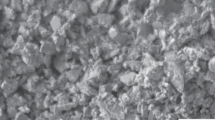Abstract
The magnetic susceptibilities of powder titanium and nickel were measured over a wide range of porosities. the effect of consolidation during the sintering of conglomerates on the magnetic properties of the investigated materials was determined. The dependence of magnetic properties on porosity was explained on the basis of a physical analysis of the factors controlling the development of magnetic properties in powder materials.
Similar content being viewed by others
References
V. V. Polyakov and A. V. Egorov, “Dependence of the magnetic permeability of ferromagnetic powder materials on particle size,” Poroshk. Metall. Nos. 1–2, 9–11 (1994).
I. D. Radomysel'skii, G. I. Yaglo, and N. F. Efremova, “Effect of particle size on the magnetic properties of powders and finished components,” ibid., No. 1, 73–76 (1984).
B. A. James and G. Williams, “Review of the magnetic properties of sintered iron,” Powder Met., No. 2, 75–87 (1979).
V. V. Polyakov and A. V. Egorov, “Eddy-current testing of the specific electrical conductivity and magnetic permeability of magnetically soft components,” Defektoskopiya, No. 12, 78–80 (1992).
V. V. Polyakov, A. V. Egorov, and V. A. Turetskii, “Effect of the structure of powder agglomerates on their electrical and magnetic properties,” in: Problemy Promyshlennykh SVS-Tekhnologii [in Russian], Barnaul (1994), pp. 109–113.
V. V. Polyakov and A. V. Egorov, “Initial magnetic susceptibility of porous ferromagnetic materials,” Fiz. Met. Metalloved,76, No. 1, 172–174 (1993).
Ch. Kittel, Introduction to the Physics of Solid Bodies [Russian Translation], Nauka, Moscow (1978).
V. V. Polyakov and A. V. Egorov, “Magnetic permeability of porous soft magnetic metals,” Izv. Vyssh. Uchebn. Zaved. Chern. Metall., No. 2, 36–37 (1994).
S. V. Vonsovskii and Ya. S. Shur, Ferromagnetism [in Russian], OGIZ, Moscow—Leningrad (1948).
E. I. Kondorskii, “Theory of the magnetic properties of conglomerates and powders,” Izv. Akad. Nauk. SSSR, Ser. Geografiya i Geofizika,14, No. 4, 294–301 (1950).
V. V. Polyakov and A. V. Egorov, “Effect of the structure of highly porous ferromagnetic materials on magnetic susceptibility,” Fiz. Met. Metalloved.,77, No. 6, 41–43 (1994).
S. Tukadzumi, Physics of Ferromagnetism. Magnetic Properties and Practical Applications [Russian Translation], Mir, Moscow (1987).
Additional information
Altai State University, Barnaul. Translated from Poroshkovaya Metallurgiya, Nos. 3–4(400), pp. 36–38, March–April, 1998.
Rights and permissions
About this article
Cite this article
Polyakov, V.V., Egorov, A.V. & Turetskii, V.A. Mechanisms of formation of the magnetic properties of powder metallurgy materials. Powder Metall Met Ceram 37, 158–160 (1998). https://doi.org/10.1007/BF02675975
Received:
Issue Date:
DOI: https://doi.org/10.1007/BF02675975




